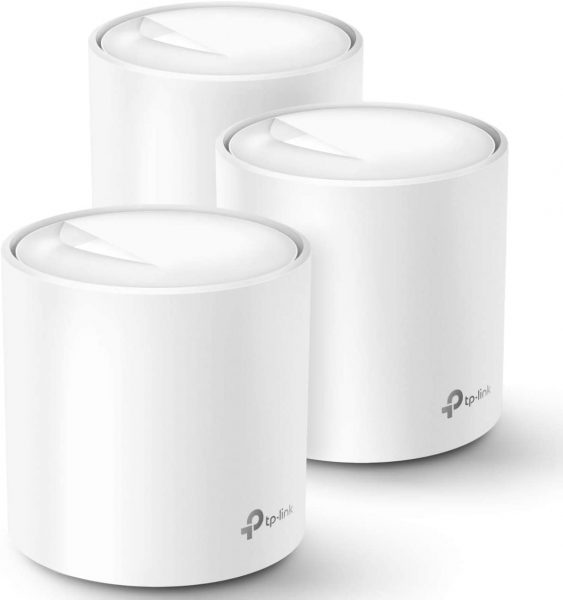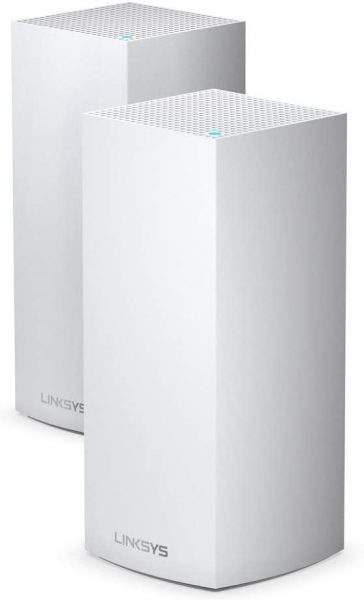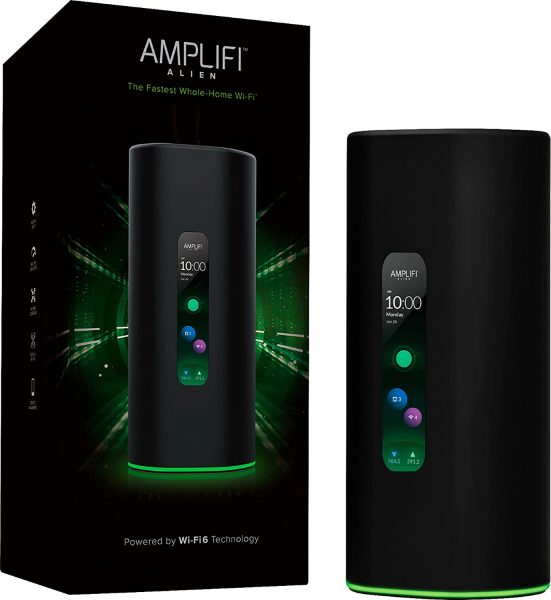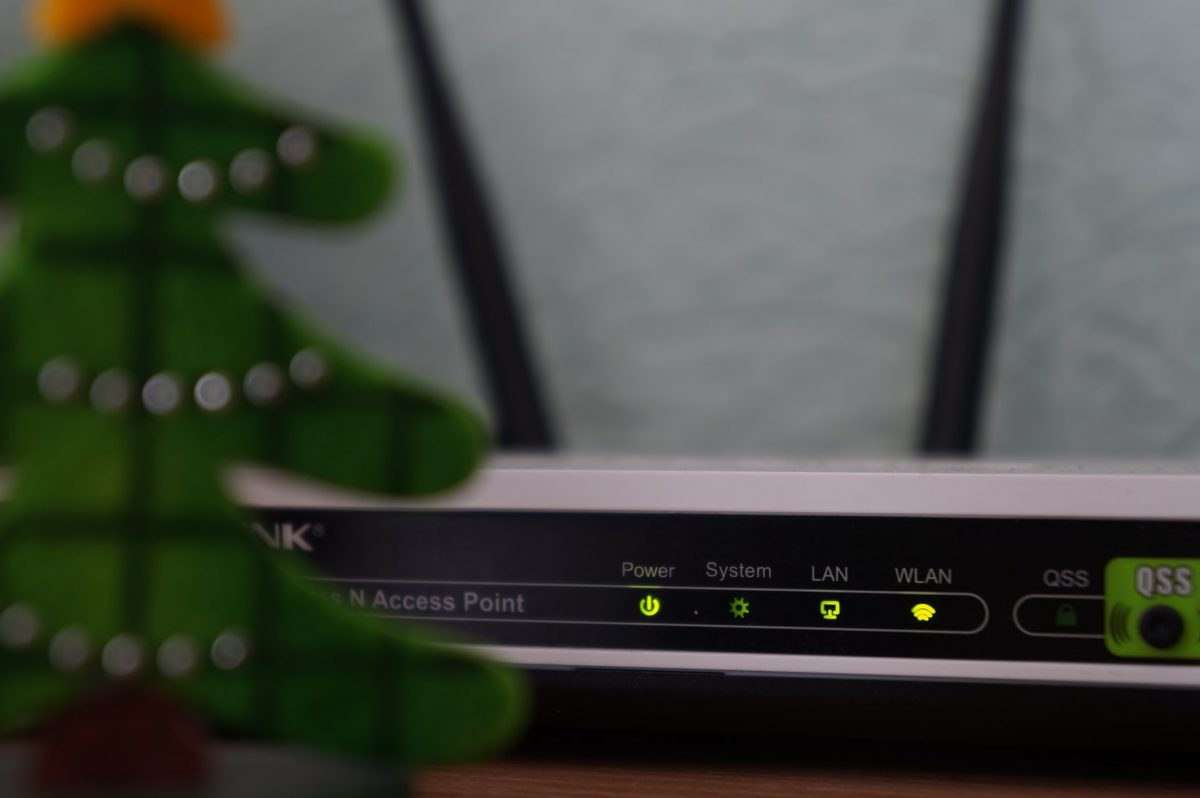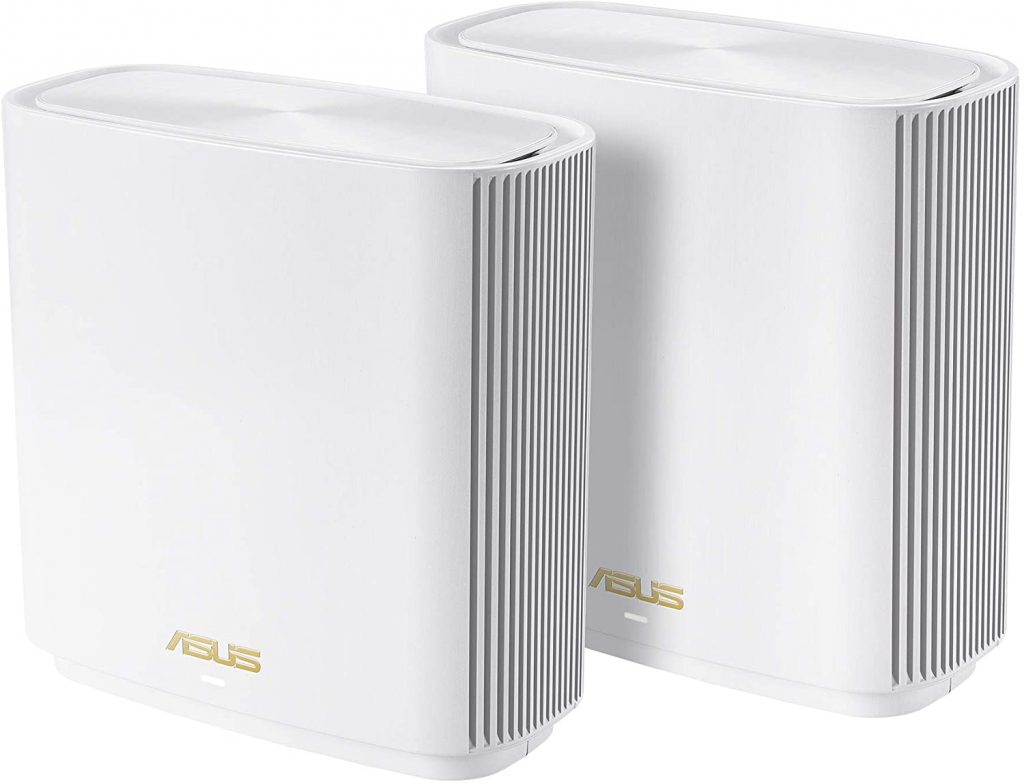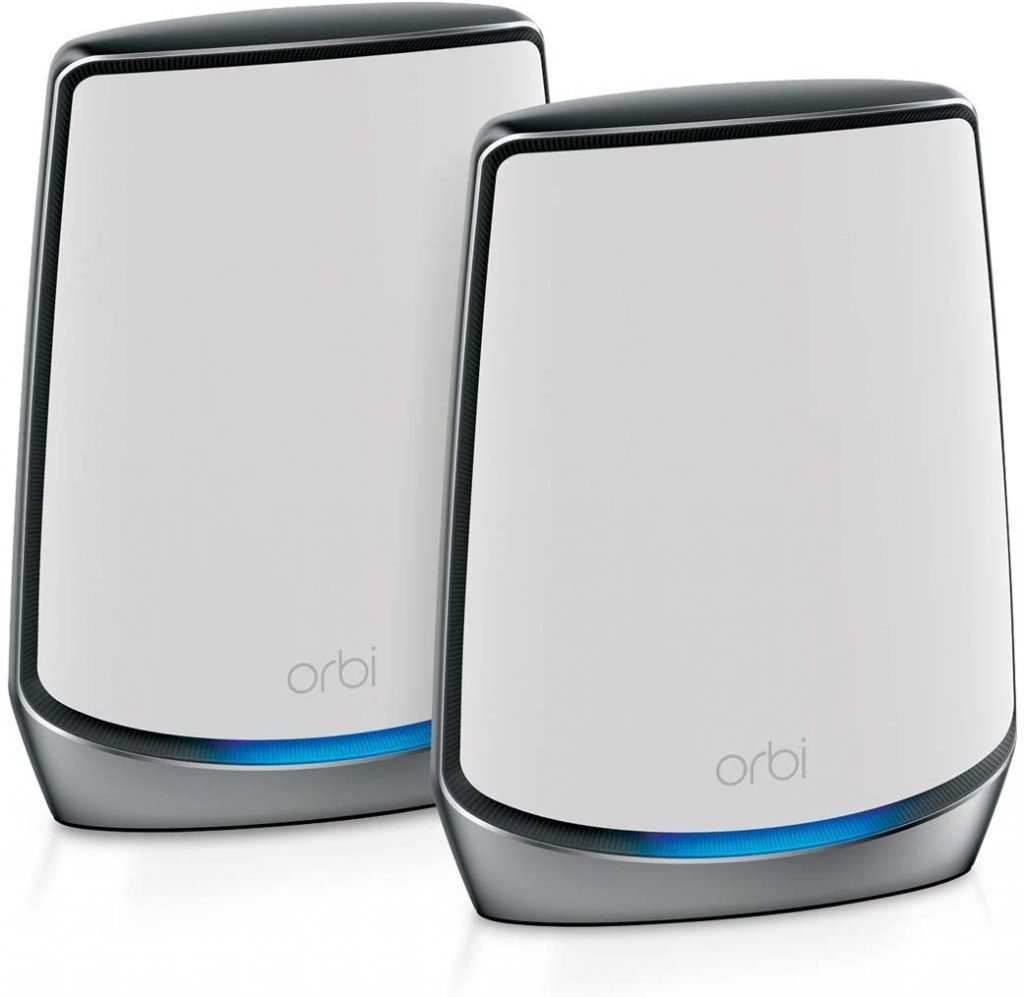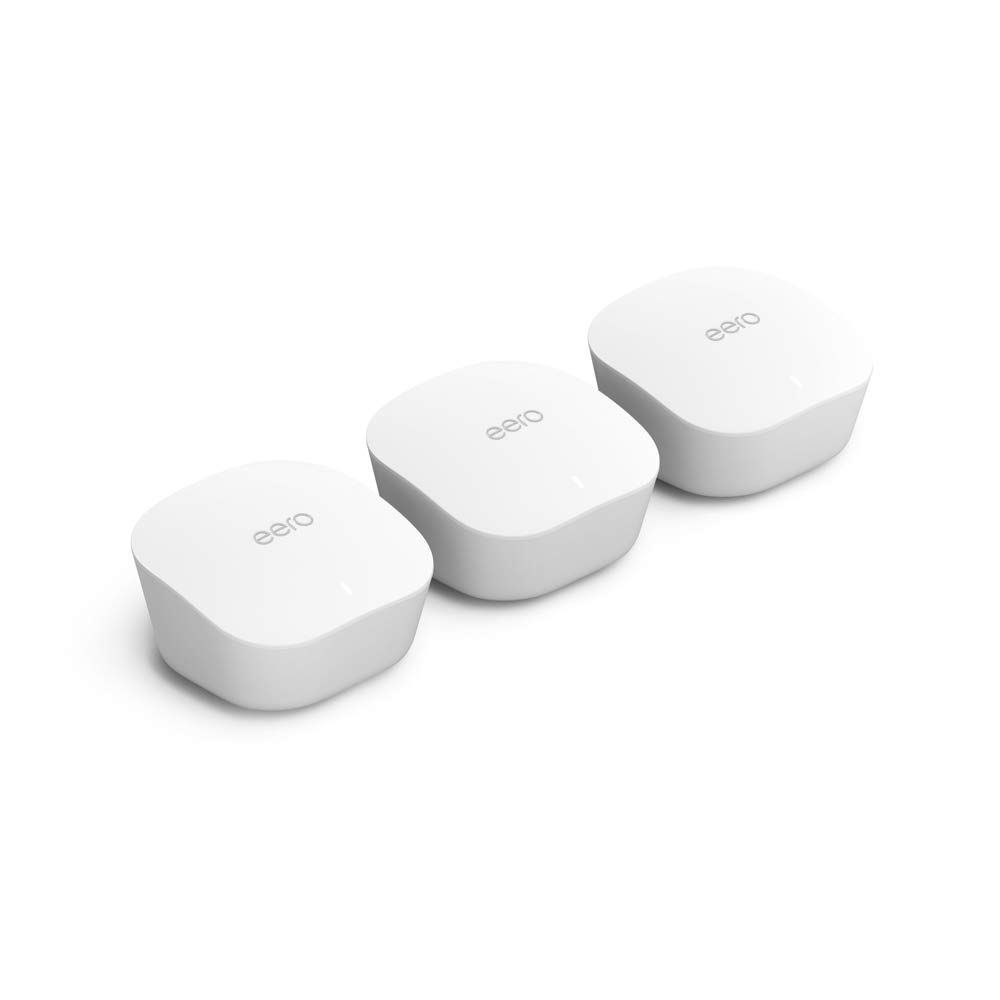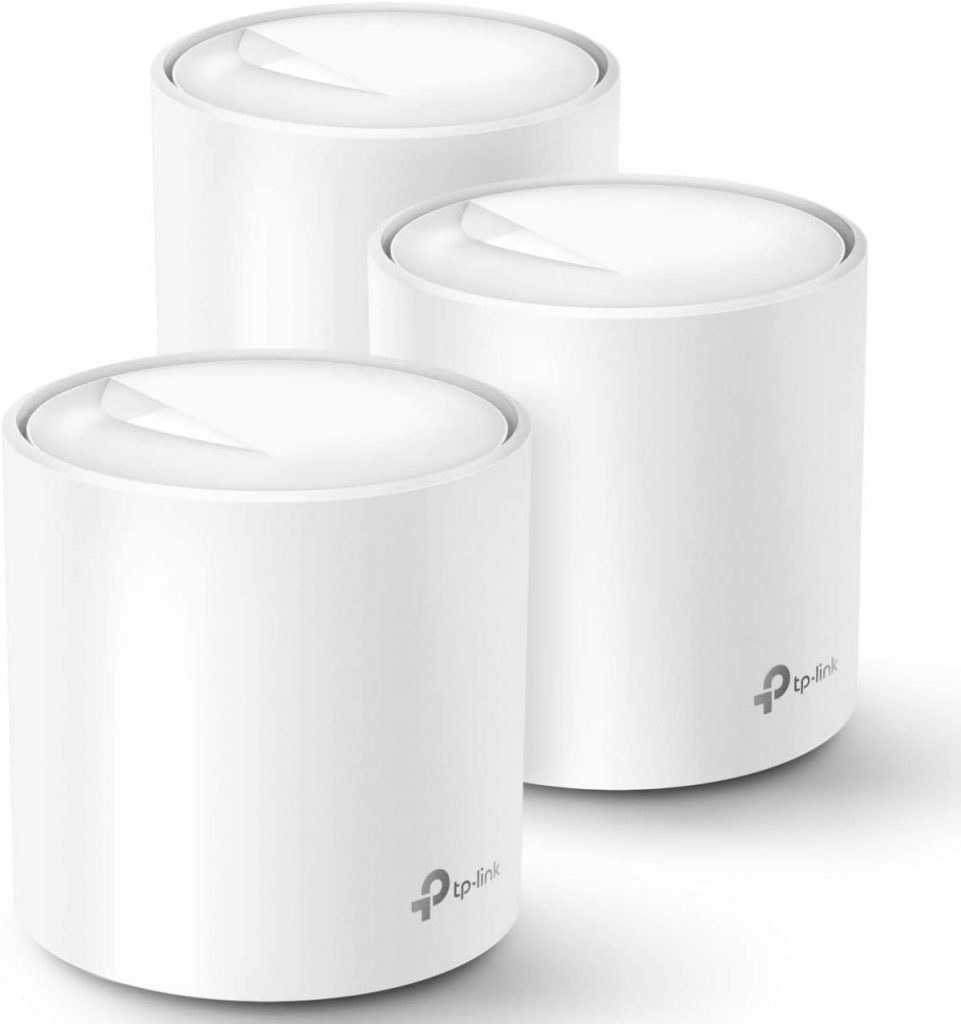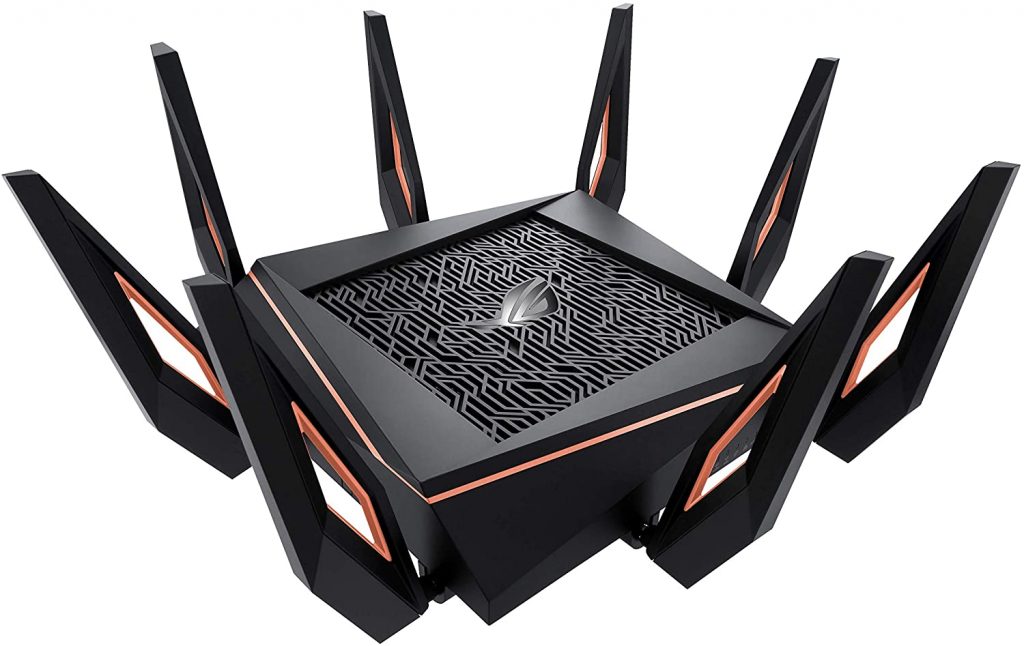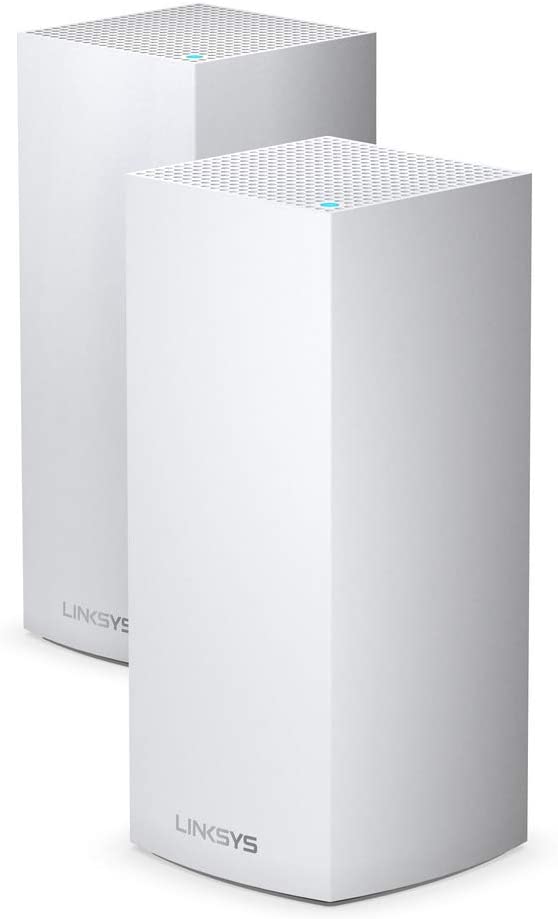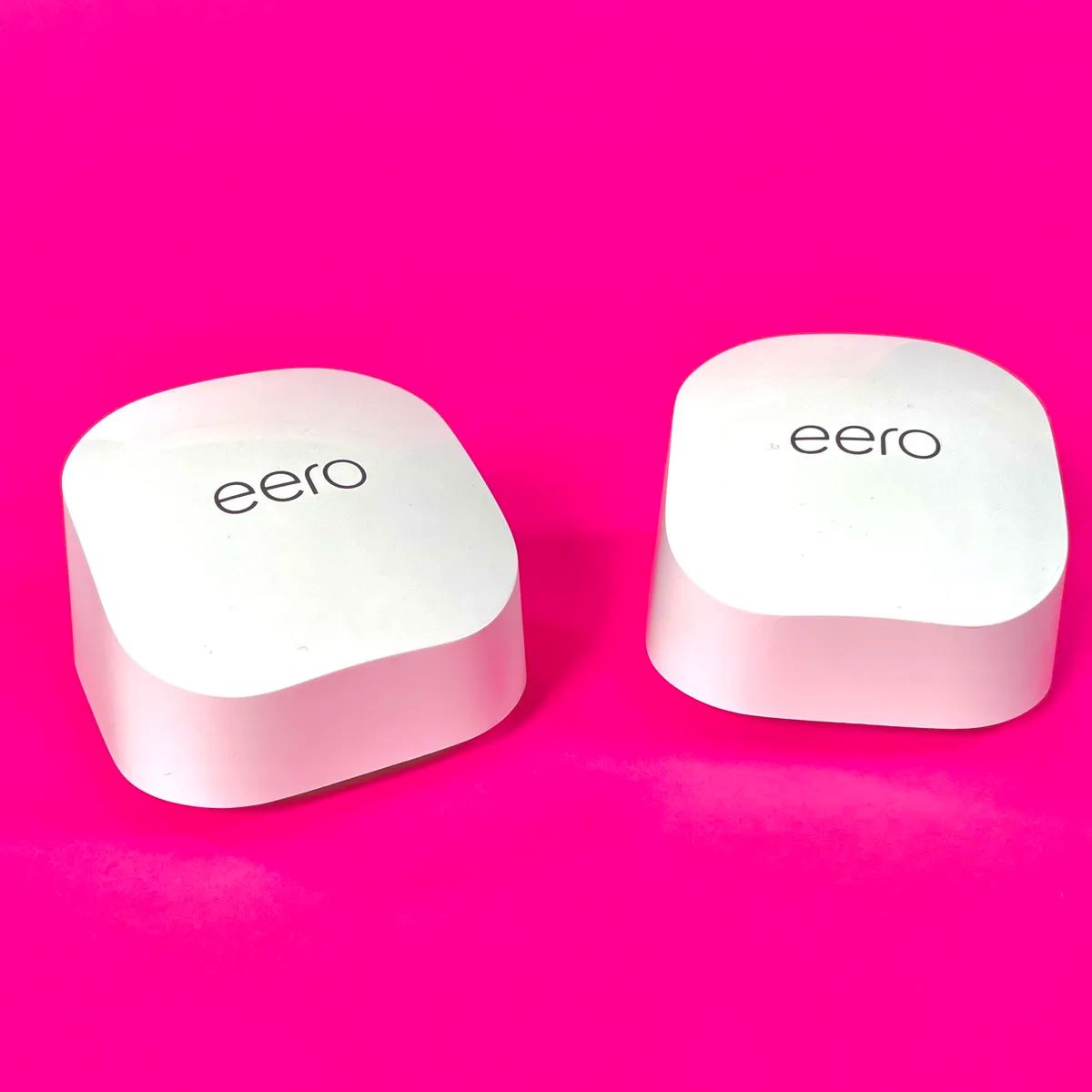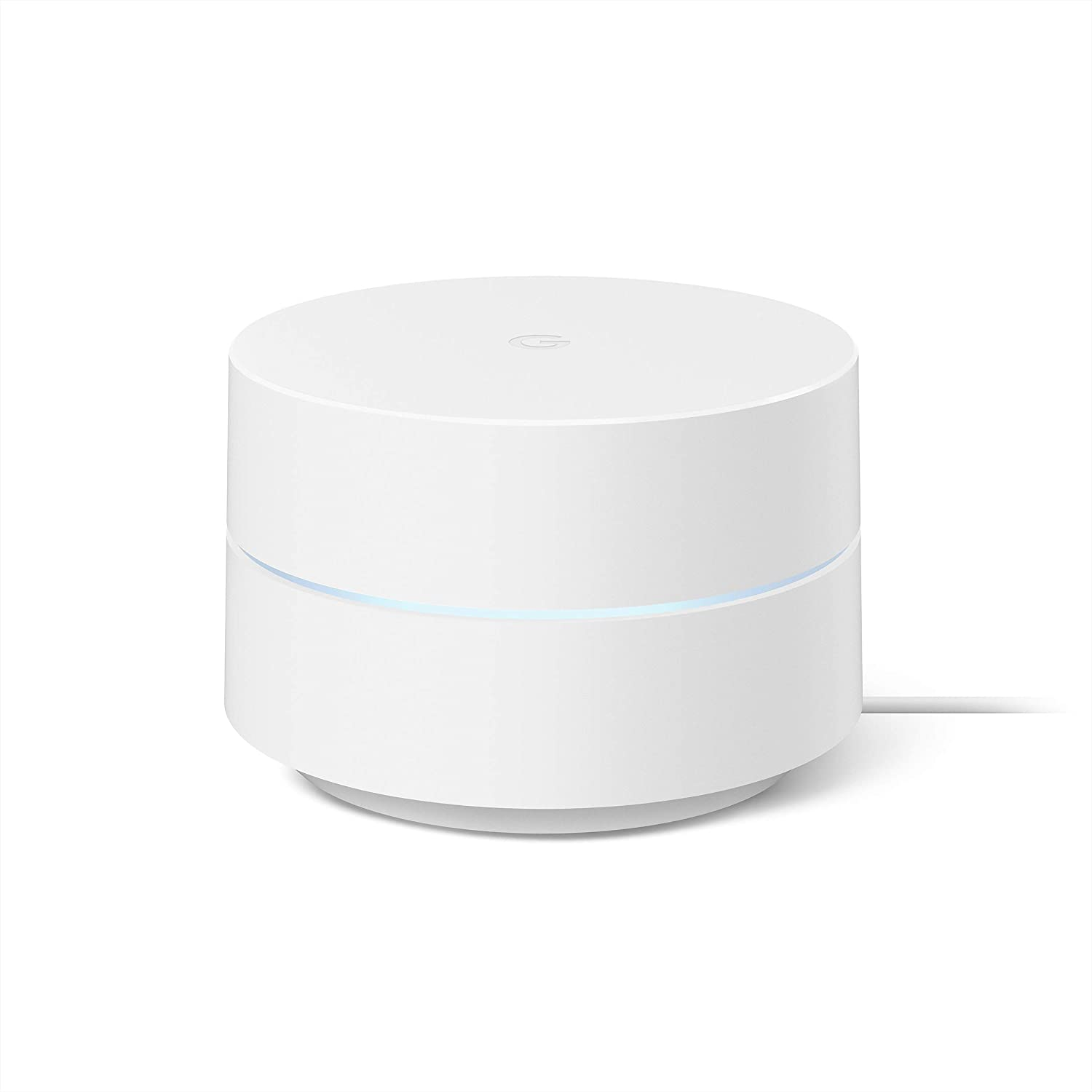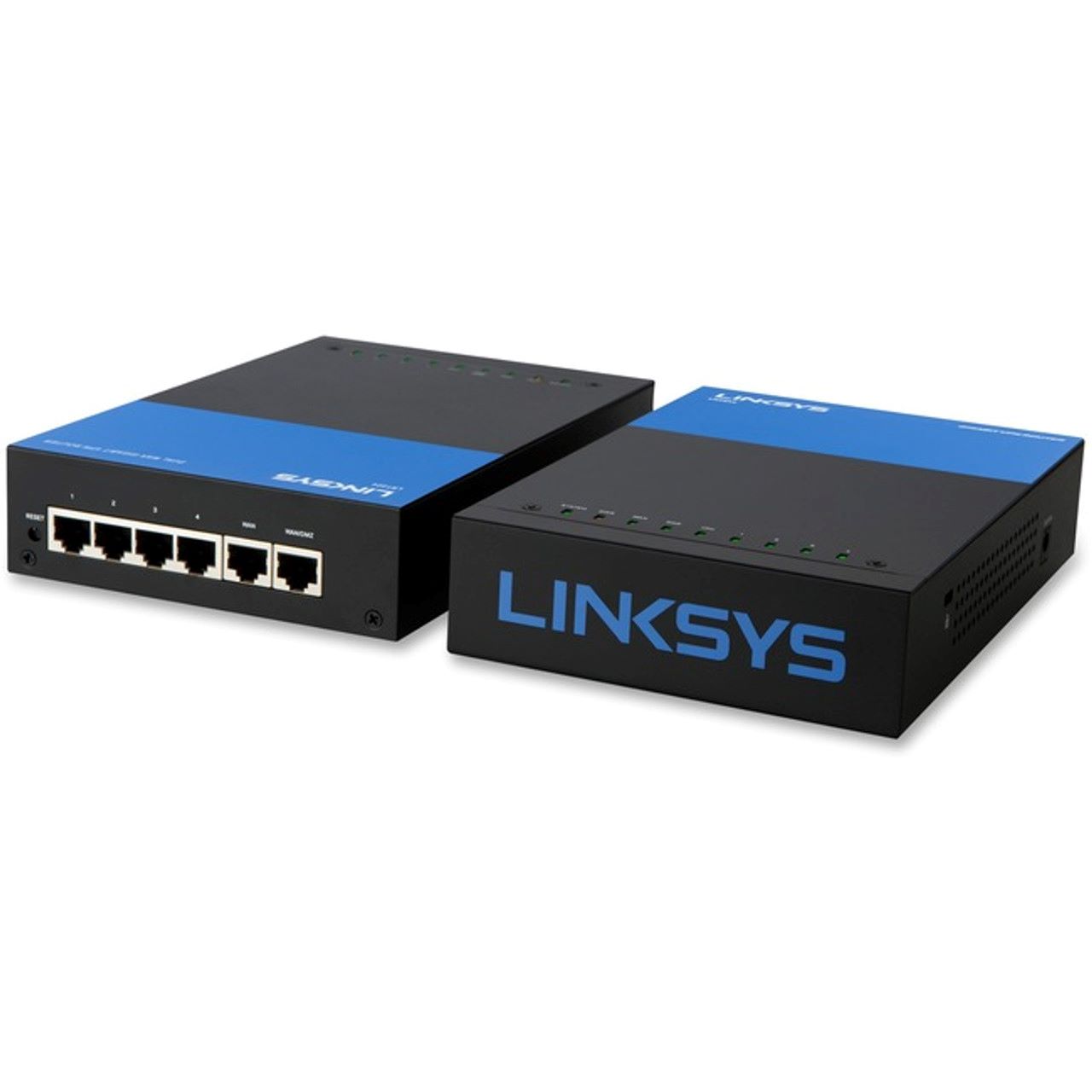The best Wi-Fi 6 mesh routers eliminate the “dead spots” within your home to deliver fast and reliable internet throughout. These routers offer support for the latest generation standard, Wi-Fi 6, which comes with its performance, security, and resource efficiency upgrades. They also function completely wirelessly for better coverage.
Let’s take a look at some of the best Wi-Fi 6 mesh routers offering the best coverage for your home or business.
What Is a Mesh Router?
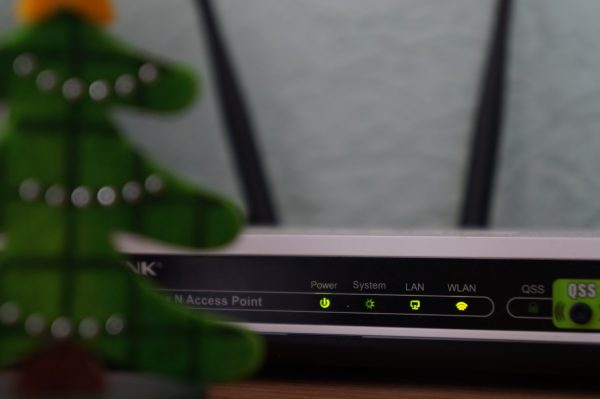

Before we can understand the concept of a mesh router, we first need to clarify what a router is in the first place. A router is a device that connects to the internet through a modem that connects other devices on the network.
A router manages and processes all data passing through your network, making them a crucial component of your internet speeds. It is often a standalone device with a single access point and a large area to cover. While effective at close range, the standalone factor usually leaves a lot of areas without a connection, which is also known as “dead spots.” This is where mesh routers come in.
Mesh routers work similarly to standard routers, except that there are more of them in a system with multiple access points. A mesh system still includes a traditional router that connects to the internet via a wired connection with a modem. However, the difference is that the router is supported by other router-like devices called satellites.
Each satellite or node can function completely wirelessly, and a handful of them can be placed in strategic locations across a given surface area. Together, these devices form a mesh network that allows them to send and receive signals from the main router onto devices and vice versa. The mesh network also allows the satellites to communicate with each other as well as with the main router.
Each satellite has a given coverage in terms of signal, and the coverage of multiple satellites “overlap.” The overlapping signals extend your coverage in a blanket-like fashion and help eliminate the so-called “dead spots.” The total coverage that you get depends on the number of satellites and their coverage.
A select few mesh systems already offer support for the latest protocols for wireless internet, Wi-Fi 6. The features that come with the Wi-Fi 6 standard offer a significant boost to an already-efficient mesh system by increasing overall bandwidths, helping devices save on battery life, reducing network congestion, and improving network security.
8 Best Wi-Fi 6 Mesh Routers for a Seamless Connection
Mesh routers offer the best speeds, lowest latencies, and best coverage compared to other routers. In combination with the advanced features that come with a Wi-Fi 6 standard, these routers become even faster and more efficient. Unfortunately, not all mesh routers are of the mesh variety, and even fewer support Wi-Fi 6.
We’ve compiled some of the best routers that fit both criteria, so you no longer have to search in the dark:
The ASUS Zen Wi-Fi XT8 is one of the more expensive options on this list, but that has more to do with its Wi-Fi 6 capacity than anything else. It offers great performance and features hiding underneath a simple package, so there is little doubt that the Wi-Fi XT8 is one of the best Wi-Fi 6 mesh routers in the market.
Design
The white, rounded square units have a very minimalistic yet sophisticated design. Each unit comes with a plastic case that’s smoothed out at the front and in the back, with slightly rugged and aerated side panels. A unit is just tall enough to fit inside a bookcase section or on top of a table and light enough to be transferred anywhere.
In keeping with its minimalistic design, there are only two colors to choose from, and it’s either black or white. The black version looks very similar to the older ZenWifi AC (CT8), but the two run on different Wi-Fi protocols.
Price and Availability
The mesh unit is available in packages containing one or two devices. A package with two devices costs slightly upwards of USD 2,000, while a single unit costs just over USD 1,500.
In truth, these price points are quite expensive. But then again, you are paying for reliable internet speeds as well as durability with the system.
Top Speeds
The Wi-Fi XT8 is a tri-band router, which means that it features both the 2.4GHz and two 5.0GHz network bands. All three bands offer support for the latest Wi-Fi standard, the 802.11ax, also known as Wi-Fi 6.
Because of Wi-Fi 6, the router can deliver a close-range speed of about 1201Mbps. As for the individual bands, it delivers a top speed of 4804Mbps speed over the 5GHz band and 574Mbps speed over the 2.4Ghz band. Actual speeds vary depending on the proximity of the device from the router/s.
When it comes to coverage, a single unit can cover an average surface area of 2,750 square feet (sq. ft), while two devices working together can cover an average surface area of up to 5,500 sq. ft. This coverage is pretty impressive on its own, but not exceptionally so within the context of mesh capabilities.
Notable Features
If you are using Wi-Fi 6 for the first time, you’re probably worried that some of your devices will not be able to support it. But in reality, you shouldn’t worry too much since Wi-Fi 6 was designed to be backward compatible. That means that the majority of the devices that you have will be able to work with it even though most do not directly support the protocol.
Another laudable aspect of the XT8 is that it is a troubleshooting mechanism for when your internet goes haywire. Each router is outfitted with a 2.5 gigabit Ethernet port for your devices to plug into when a wireless connection does not suffice. It also features a USB-C port that you can use to plug in USB-type storage to make it available to everyone on the network.
For the two-pack mesh setup, Asus has set aside one of the 5.0GHz as a special pathway for the satellite devices to communicate with the main router. Normally, the router and the satellites would share the same bands to send out signals to client devices, which often leads to a signal loss.
With a dedicated band, the satellites and the main router can communicate at high speeds and without interference with minimal risk of signal loss. Meanwhile, the remaining 2.4GHz and 5.0GHz bands are left to share the internet signals to your other devices.
The Netgear Orbi RBK852 is a stylish yet modern mesh device that is a great fit for both home use and office use. Composed of multiple units, the system is a high-performing option for its price range, which makes it one of the best Wi-Fi 6 mesh routers you can get.
Design
Each unit takes up Orbi’s distinctive rounded tower shape, wrapped in white plastic material with a chrome trim at the bottom. The thin bezel surrounding the device’s front panel lights up in blue when the device is active, which is a pretty nice touch. The color scheme and LED light combination make for a gorgeous and futuristic-looking design.
On the other hand, the size and build of each unit make it so conspicuous that you probably won’t be able to hide it well. Each unit has a form factor with the following dimensions: 11.1 x 7.5 x 3.0 inches. This makes it tower over other mesh router units in the market, including the ASUS Zen Wi-Fi AX XT8 mesh units.
These powerful components are underneath that gorgeous design like Qualcomm’s Networking Pro 1610 chipset and a 2.2GHz quad-core processor. Other components include 1GB of active memory and 512MB of storage space for the router’s settings and firmware.
Price and Availability
The Orbi starter kit contains two devices, which will set you back around USD 400. The two devices consist of a router and satellite pair. They are not interchangeable, and you cannot purchase the router individually apart from the pair. But what you can do is purchase additional routers, which will cost USD 250 each.
While USD 250 is not cheap, you can always take advantage of Orbi’s sales and discounts. For example, a recent sale that put up a package of three devices for only USD 450 or a four-device package for only USD 599. That equates to hundreds of dollars in savings at the end of the day.
Top Speeds
The Netgear Orbi is a tri-band router, which means it supports a single 2.4GHz network band and two 5.0GHz network bands. The extra band is presumably a backhaul for the satellites and the router, which makes for a more stable connection.
The basic package with a single router and satellite can already get your seamless Wi-Fi at an average speed of 4.2Gbps. On top of that, a simple setup such as this can already support up to 40 devices, which is simply amazing.
This high-powered system may be simple to look at, but it can deliver high speeds of 1200 Mbps at close range. The individual bands can deliver a maximum speed of 2400Mbps for the 5GHz band and 600 Mbps for the 2.4GHz band.
When it comes to which bandwidth is better, the answer is neither. The 5GHz band will take over for short-range, high-bandwidth activities, while the 2.4GHz band will take over for longer-range, less demanding activities. The router automatically switches between these two bands to fit in with the network’s current needs.
As for coverage, it largely depends on the number of satellites that you have. The basic package comes with 5,000 sq. ft, which is already more than enough for most spaces. Meanwhile, a three-pack will increase the range to up to 7,500 sq. ft, while a pack of four will double the original range to 10,000 sq. ft. However, the most you can get is 12,500 sq. ft for a five-piece setup.
Notable Features
The Netgear Orbi operates on a dual-setup, including the router and the satellite. The router has an interesting combination of ports, including a single WAN port to connect to the modem and three LAN ports for connecting your devices directly into the router.
The satellite also contains four LAN ports for plugging in devices directly. Additionally, it was designed in a way that it can only work with an Orbi router. In other words, you probably shouldn’t try to use a router from another brand because it wouldn’t be able to communicate with the satellite.
Similar to the ASUS Zen Wi-Fi XT8, the Orbi also reserves one of the two 5.0GHz bands to connect the main router and the satellites. This access route is separate from the other two bands, which are left to distribute those signals to client devices within the proximity.
The Amazon Eero Pro 6 is Amazon’s version of the mesh router system, and it’s a highly efficient and competitive system at that. With ultra-fast speeds and an extra 5GHz band, not to mention support for Wi-Fi 6, this router promises to give you the best performance that mesh technology can offer.
Design
As the third generation of Eero Pro products, the Pro 6 takes after the look and feel of its predecessors, only slightly larger. Each unit has a white plastic rectangular design and a slightly angled top, which makes it look like a butter dish or a jewelry box.
At the back of each unit is a rudimentary connection panel with two Ethernet connections, both of which can send out 1 Gbps of data. A USB-C type port for power is between the Ethernet ports, but you can stick to the AC adapters to power up the device.
Internally, each unit has an antenna for both Bluetooth and Zigbee connections, for setup and connecting smart home devices, respectively. It also contains five Wi-Fi antennas for dispersing Wi-Fi signals. But at the heart of the device, and the one thing that makes everything possible is Qualcomm’s IPQ8174 Wi-Fi chip.
Price and Availability
The Eero Pro 6 costs slightly upwards of USD 200 for a standalone unit, USD 399 for a two-device-pack, and a little less than USD 599 for a three-device pack.
While this price range can hardly be considered cheap, it’s still a lot cheaper than some of the Wi-Fi 5 mesh routers in the market. The units are available on Eero’s website, Amazon, and other retail websites.
Additional controls like parental controls and anti-malware are also available, but not for free. You would have to unlock either a Secure Plan to get a content filter for websites, an ad-blocker, as well as a website scanner. A Secure Plus plan will get you all of that, plus access to anti-malware software, VPN, and a password manager.
Interchangeable Nodes
Now, if you paid attention, you might have noticed that the basic package only contains a single device. The truth is Eero Pro devices are interchangeable, meaning each device can function either as a router or satellite at any time.
In other words, you can simply select a device and assign that as your router or satellite, and it can work both ways. Each router also has the same range of 2,000 sq.ft, which should make it easier for you to find the perfect spot.
Top Speeds
The Eero Pro 6 is a tri-band mesh system, which means that it contains an extra 5GHz band to speed up system performance. The triband was specially designed to maximize internet connections with gigabit speeds, and it can pull data wirelessly for a range of up to 2,000 sq. ft.
The tri-band system helps to improve system performance to a considerable degree, but the actual speeds vary per band. The 2.4GHz band can hit the largest data rates of up to 574Mbps, which is expectedly lower than the two 5GHz bands. Meanwhile, theoretical maximum speeds for the two 5GHz bands fall at 1,201Mbps and 2,402 Mbps.
Notable Features
The Eero Pro is also based on the Wi-Fi 6 (802.11ax) standard, which means that it can take advantage of the latest technologies to speed up connections in the process. It also supports WPA3 encryption, making your passwords harder to crack and stolen data harder to encrypt. It will also make it easier for you to connect to the internet at home and keep you safe on public Wi-Fi.
The Wi-Fi 6 features that come with the system include the Multi-user multiple input, multiple outputs (MU-MIMO), a technology that allows multiple devices to stream data simultaneously. Other highly technical features such as the Orthogonal Frequency-Division Multiple Access (OFDMA) data transmissions and direct-to-client beamforming are also possible. Unfortunately, the system doesn’t offer support for the 160MHz bandwidth, which is a standard feature of the 5GHz.
The TP-Link Deco X20 is a relatively compact and lightweight mesh system that offers a great balance between performance and value. With fast speeds and a great range, plus a lot of special features such as parental controls, the Deco X2 is one of the best Wi-Fi 6 mesh routers.
Design
Each unit has a white and smooth exterior and cylindrical shape. Its small and light form factor makes it about a third of the full size of an average mesh satellite. This should allow the device to fit into any setup, whether that be on top of a table or a bookshelf case. Not to mention, the only color option for this device is white.
At the front of each unit is a small LED indicator light that lights up in different colors to let you know about the device’s status. At the back of each unit are two gigabit LAN ports, one for incoming WAN and another for a networking device. Each device is also outfitted with a cooling unit underneath. The only thing missing is mounting inserts for hanging them onto the wall.
Interior-wise, each device is outfitted with four antennas that take in both Bluetooth and internet signals. Each device’s core is a Qualcomm Pro 400 chip and a processor for the router’s firmware and settings.
Price and Availability
The TP-Link Deco X20 devices are generally sold in packs of ones, twos, or threes, but you can create a mesh system with as many devices as you need. Prices tend to vary, but a pack of two would generally cost you an average of USD 200. This package should suffice for a surface area of around 200 sq. ft. In comparison, Orbi’s two-device setup costs roughly twice that amount, which goes to show its value for money.
Top Speeds
Unlike the Netgear Orbi or the Eero Pro 6, the TP-Link Deco X20 is a dual-band router, which means that it only contains a single 2.4GHz band and another 5GHz band. This setup, while not as optimized as a tri-band setup, can still deliver fast speeds of up to 1200Mbps for the 5GHz as well as 575Mbps for the 2.4GHz band.
In the case of a dual-band system, the 2.4GHz and 5GHz bands perform a dual function. This includes transmitting data from the satellites to the router as well as transmitting signals to devices in the periphery. The absence of an extra 5GHz network channel translates to the lack of an exclusive pathway for satellite-router communication.
Notable Features
Despite their lightweight and compact form factor, these devices can pack a punch, performance-wise. For starters, it offers support for 802.11ax (Wi-Fi 6) technologies. This, of course, comes with the standard technicalities, including WPA3 encryption, 1024 QAM, and OFDMA data transmissions. It also comes with MU-MIMO for simultaneous streaming across multiple devices, as well as targeted beamforming.
TP-Link Deco routers have their dedicated app and are also compatible with Amazon Alexa. The software is available through either mobile or desktop. We need to note that the mobile app is more robust than the desktop app, as the latter is limited to firmware upgrades and time zone settings. The device also works with Amazon Alexa, allowing you to control the router using voice commands.
The mobile app allows you to monitor all devices connected to your mesh network and configure operational settings such as download and upload speeds. It also comes with antivirus security for your network, advanced parental controls, and Quality of Service (QoS) settings.
The Netgear Nighthawk MK63S is a user-friendly and future-proof mesh solution ideal for both large houses as well as smaller houses with more sources of interference.
This mesh system is the triple-device variant from the Nighthawk mesh router line, with two satellites and a single router. It follows closely in the footsteps of its predecessor, the MK62S, which has a single router and a satellite.
Design
Each device has a box-like form factor, with a checkered, glossy pattern at the top and a smooth, marble-finish surface at the sides. Each device is about the size of a small cookie box, which should allow it to fit in easily on any shelf, window ledge, or table. Each unit has four plastic pegs at the bottom to stand on and keep it from touching the surface wherever you decide to put it.
At the device’s front panel is a stick-like LED indicator, located smack in the middle at the top and above the Netgear logo at the bottom. There are three Ethernet ports at the back of the device. One can connect directly to a satellite and two can connect directly to your devices.
One of the Ethernet ports at the back of the router will be required to connect to your broadband modem. This leaves the other port free to connect to your gaming console or smart TV devices. The same can be said for the single Ethernet port at the back of each satellite, and you can use it to plug in your devices.
The Nighthawk is only available in black, a color that Netgear normally reserves for their more serious gaming routers.
Price and Availability
The Nighthawk MK63S is sold as a mesh network for the home, which means that you cannot buy it individually.
The three-device package normally retails for a price point smack in between USD 600 and USD 700. The MK62S is understandably cheaper at USD 449 with one less satellite in tow.
If you shop around online, you may be able to get the mesh system for about half the price.
MK62s vs. MK63s
So what’s the difference between the MK63S and MK62S, you may ask? For starters, the MK62S was designed for smaller homes or spaces with a work area of about 2,000 sq. ft. Meanwhile, the MK63S was designed for larger homes or spaces with work areas of about 3,500 sq. ft.
If you do the math, each satellite would be able to cover about 140 sq. ft. Nonetheless, the two systems are identical in terms of both design and performance.
If you want to find out more about the MK62S as well as other routers like it, check out this article exploring the best Netgear routers you’ll ever need for seamless browsing.
Top Speeds
The Nighthawk MK63S is a dual-band router, which means it automatically shifts devices between the 2.4GHz band and 5GHz band. The system of three can work with up to 25 devices at a time, although most of those devices would have to support Wi-Fi 6 to support OFDMA.
The absence of a third channel also means it doesn’t have a backhaul for the satellite-router connection. Nonetheless, the router tries to compensate for this by offering a wired Ethernet backhaul. However, this system can only work with one satellite at a time, meaning the other satellite could easily lose its connection with the router.
Nonetheless, the system was designed to support Wi-Fi 6 technologies and devices, which translates to faster speeds overall. Wi-Fi 6 is backward compatible, so this mesh system should have no trouble working with both the latest gadgets as well as older devices.
When it comes to actual speeds, the mesh system can deliver maximum speeds of up to 1200Mbps for the 5GHz band and 600Mbps for the 2.4GHz band. Naturally, actual speeds will vary due to external factors such as interference.
Notable Features
One thing you’ll notice about the setup is that the units are practically identical. All have the same black color, box-like form factor, and physical dimensions.
One way to tell the devices apart is by looking at their ports at the back of each device. The router should have two Ethernet ports, while the satellites should have one. A sticker at the bottom of each device should also indicate whether it is a satellite or a router.
And of course, what would a mesh system be without a mobile app to control it? The mobile app in this case makes it very easy to set up and manage the system, and it also has a lot of features. One feature lets you monitor all devices connected to the network. Another feature lets you cut off the connection for a particular device from the router, but you’ll have to type in the device’s MAC address.
Other useful features include an option for creating a guest network, as well as conducting a full-on speed test for your internet. The app will also offer you in-depth data about the more technical aspects of your network, including security protocols, data usage, and connected devices. Another feature called “Netgear Armor” can offer you network-level device protection, but it is locked under a paywall.
The ASUS ROG Rapture FT-AX11000 is a mean-looking device with a unique form factor and is exceptionally sturdy. While being one of the more expensive options on this list, the device certainly works for its keep, with its versatility and exceptional throughput speeds.
Design
The Rapture FT-AX11000 is a beast of a router, and we mean that description quite literally. The 3.94 lbs (1.79 kg) router has a heavy-set centerpiece surrounded by eight large and weirdly-shaped antennas. They give the router the appearance of an upside-down robotic spider or an alien spaceship on Battlestar Galactica. Either way, this is very robust and unique design.
There’s not much in the way of lights for this router, except maybe for the LED buttons at the front and the ROG logo on top. In keeping with the Asus trademark, the ROG logo is emblazoned at the top of the router. The logo lights up with RGB colors whenever the router is turned on. Because nothing else screams “gaming unit” better than RBG color panels. Hardware-wise, the router is powered at the core by a quad-core CPU, flash storage and RAM.
The Rapture FT-AX11000 has five gigabit Ethernet ports, four of which are for LAN and the remaining port for WAN. But the most interesting port is the 2.5Gbps Ethernet port, which you can use to send “high-priority” data. Additionally, both the WAN and LAN/WAN ports also alternate as gigabit ports for high-bandwidth data transmission.
Price and Availability
Appearances aside, Rapture FT-AX11000 is a powerful and ambitious device that seeks to deliver on all fronts: wireless connectivity speeds, security features, hardware, and special features for gamers. It also offers support for Wi-Fi 6, which should allow you to make the most out of newer devices and older devices alike.
But with great features and design comes great cost, and for this unit, in particular, you would have to shell out around USD 450. Nonetheless, this price point is still well within the standard range for mesh routers with Wi-Fi 6.
Top Speeds
The Rapture FT-AX11000 is a tri-band router, which means that three bands automatically switch from each other to accommodate the needs of the different devices in the network. The tri-band arrangement delivers a theoretical maximum bandwidth of 1148Mbps on the 2.4GHz band and 4804Mbps on each of the two available 5GHz bands.
The differences in speed are to be expected since 2.4GHz bands are able to achieve a broader coverage but sacrifice speed, while the 5GHz bands provide faster speeds but are limited to a smaller area.
Most tri-bands assign one of the bands, usually the 5Ghz band, as a backhaul mechanism to keep the satellites connected to the router. But knowing that the GT-AX11000 is an integrated unit with a powerful processor and multiple antennas to cover for the nodes, then there really doesn’t seem to be a need for an extra backhaul mechanism for it.
Notable Features
The Rapture FT-AX11000 comes with a dedicated mobile app that lets you control the minute details of your mesh experience. It allows you to manage several things, from simple tasks such as renaming your network and creating a password to more complicated tasks such as limiting bandwidth or blacklisting devices from the network.
The app also serves as the dropping point for system information collected by the router. It includes things such as system performance, settings, as well as usage information. Moreover, its network diagnosis tool can help you identify the source of an issue across the path of signal transmission. Because again, there are other potential causes for your network connectivity problems other than the router.
In addition to basic features, the app also houses a collection of novel features for you to explore. Most are interest-specific, and by that, we mean specific to gaming. One example of a notable gaming feature is “Game Radar,” which allows you to monitor online servers for your favorite games. Another example would be “Gamer’s Private Network,” which helps to reduce lags during game time.
The router system’s Wi-Fi 6 functionality should get you additional features like channel sharing through OFDMA, simultaneous channeling with MU-MIMO, targeted beamforming, faster encoding rates, and 160MHz channel utilization.
The Linksys MX8000 is a sophisticated yet straightforward mesh solution designed to cover both indoor and outdoor spaces. The powerful range and performance are backed by an easy installation process and a highly convenient router management system.
Design
The white, rectangular towers sport a minimalistic and no-nonsense design. Each unit is light enough to carry across different locations, as any mesh router should be. The top section of each unit is covered in a mesh screen-type material for ventilation, while the front section of the unit sports an LED indicator that lets you know the activity status of the device.
Each unit has five ports, one for WAN, three for gigabit LAN, and one USB 3.0 port. The WAN port connects the unit directly to the modem, while the LAN ports are your first line of defense against a weak internet connection. It connects to external devices such as laptops, televisions, and gaming consoles into the router.
Price and Availability
The Linksys MX8000 is available as a standalone device or as a package with two or three devices. A standalone device will set you back no more than USD 250, while a two-piece set will set you back no more than USD 400.
A three-device set will cost you approximately USD 500, offering the most value in exchange for your money. If you look around, you might be able to find these devices for less online.
Top Speeds
The Linksys MX8000 is a tri-band router, which means that one band is assigned to serve as a backhaul. The router can deliver an average speed of 600mbps in a 2.5GHz network band and 1200 and 2200mbps in each of the 5GHz network bands. More importantly, the router offers support for Wi-Fi 6, which comes with even better speeds and performance.
Coverage-wise, a single router can support up to 40 devices spread out across a 2,700 sq. ft radius. Make that two devices, and it should be enough to cover 80 devices within a 5,400 sq. ft. radius. Add another device to cover approximately 120 devices with an 8,100 sq. ft radius. Take note that actual speeds will vary depending on the strength of your internet connection as well as external factors.
Notable Features
The Linksys MX8000 is accompanied by a dedicated application that makes the process of network installation and management as easy as possible. The app offers controls for a lot of things, from the simplest of settings to the more complicated and technical aspects of your network.
Security controls have a special parental control feature that lets you limit your children’s access to the internet. It also features controls for things like WPA3 security, prioritization controls for your devices, guest network creation, and device blacklisting. It also features some advanced network-level security settings to protect your system from potential hackers and moochers.
If you prefer to use your computer over your phone, you can access the software via the online portal instead of through the app. During setup, you will be given a chance to choose a password for both your Wi-Fi and the router. The app will also prompt you to initiate a firmware update that will automatically download the latest bug fixes and security patches for your mesh system.
The AmpliFi Alien router is a high-end router with a very avant-garde design, excellent connectivity, and fast network speeds. It supports Wi-Fi 6 and features the unique ability to route your web traffic through your home network from anywhere in the world. These qualities combined make the AmpliFi Alien router one of the best Wi-Fi 6 mesh routers in the market.
Design
The router and node in the AmpliFi Alien setup are uniquely designed and practically identical, except for a few minor details.
The tall, cylindrical router is covered in a rubbery, latex-type rugged material to protect the router from external elements. At the front section of the router is an LCD touchscreen panel. The panel shows you the current time, internet speeds, as well as the number of devices connected to the network. Come time to upgrade your firmware; the panel will also let you know
At the bottom of the router is a thin circle of light which serves as the status indicator. You can customize the brightness for both the LCD panel and the bottom panel, or you can turn them off completely. The device is also outfitted with the right amount of ports, which includes a single WAN port at the bottom and four LAN ports at the back.
As mentioned, the nodes look a lot like the routers, with the same number of ports. But the key difference is that the satellites are missing the LED touchscreen that the routers have. They have small LED indicators arranged vertically near the bottom of the front panel and the same ring of light at the base.
Price and Availability
The AmpliFi Alien router is definitely on the more expensive side of the mesh price scale. However, it’s still not the most expensive option as far as mesh routers are concerned.
A standalone router or node will cost USD 350 to USD 400, while a pack of two devices will set you back around USD 700. Every additional device you purchase, router or satellite, will set you back the same amount as the standalone option.
Top Speeds
The AmpliFi Alien router alternates signal dispersion among three bands, two of which support Wi-Fi 6. The Wi-Fi 6 2.4GHz and 5GHz network bands can deliver speeds of 1,148Mbps and 4,800Mbps, respectively. The remaining Wi-Fi 5 5GHz band isn’t so bad, with a maximum speed of 1,733Mbps.
So how does the router manage both Wi-Fi 5 and Wi-Fi 6 devices? The answer is device steering, which is a capability that is unique to mesh routers. What happens is the router automatically segregates the older Wi-Fi 5-compatible devices from the Wi-Fi 6-compatible devices. Wi-Fi 5-compatible devices are assigned to the Wi-Fi 5 5GHz band, while Wi-Fi 6-compatible devices are assigned to the remaining bands.
Notable Features
The AmpliFi Alien router comes with a dedicated app that you can run on either Android or IOS. The app will guide you through the setup and prompt you to take care of key settings such as your network name and password. A signal strength indicator can even help you look for the ideal spot for your router or node. Other interesting features include one that lets you mark specific devices for gaming or streaming.
But hands down, the most interesting feature on the app has to be the AmpliFi Teleport. This unique feature will let you use a company-sponsored, secure virtual private network (VPN) to access your home network from any place around the globe. In other words, your web browsing information is rerouted to your home to keep “watchers” on the network from seeing its contents. The process is a bit complicated but easy to use, and it is readily accessible to any AmpliFi customer through the app.
How Do Wireless Routers Work?


A Wi-Fi mesh network uses multiple nodes that communicate with each other wirelessly to share internet signals. At the center of the system is an internet router that plugs directly into your computer’s modem, which is a device used to access the internet. The router transmits internet signals from the modem to other satellites, which then transmits them onto devices within the network.
Mesh routers continuously monitor network activity and maintain lists of devices that are connected to the network. Whenever a new node is added to the system, the network updates its list of devices so that other satellites may recognize its presence. The device then becomes a part of the network, with the ability to send and receive signals like the others.
But what makes routers so efficient is a technology that allows each unit to automatically choose the fastest and best route to send and receive information. For example, the system can automatically recognize when a router has stopped working or when a node is overloaded with tasks. It will then automatically reroute the data through another path.
A router’s main job is to connect you to the internet, and its performance affects your internet speeds to a great degree. If you find yourself struggling with a poor internet connection or otherwise have difficulty connecting to the internet, then the router may be to blame. In case your router is the problem, you will need to learn how to rule it out by checking for signs.
But then again, your router is not always the culprit for slow or intermittent internet connection, as the fault can sometimes lie in your internet provider, modem, faulty cables, or even a faulty device. To get to the root cause of the issue, it would be best to run a thorough diagnosis of your computer using both online software and observation.
Final Thoughts on the Best Wi-Fi 6 Mesh Routers for a Seamless Connection


Wi-Fi 6 mesh routers so far exceed traditional routers in delivering fast and reliable internet. From simple internet browsing to high-speed gaming and HD streaming, anything is possible with high speed and accuracy.
Additionally, the technology has convenient access to crucial features such as network customization options, built-in security options, parental controls, VPN, and the like. It’s the perfect system for an increasingly demanding internet environment, with an increasing number of devices to accommodate.
As far as getting the best internet quality and future-proofing your network is concerned, Wi-Fi 6 mesh routers are the best way to go.
Also read: The Best Wireless Routers: 2020 Buying Guide

